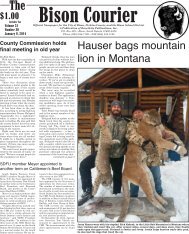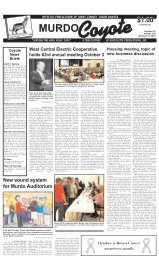South Dakota American Legion district meeting ... - Pioneer Review
South Dakota American Legion district meeting ... - Pioneer Review
South Dakota American Legion district meeting ... - Pioneer Review
You also want an ePaper? Increase the reach of your titles
YUMPU automatically turns print PDFs into web optimized ePapers that Google loves.
Structural changes to the<br />
cattle feeding industry<br />
The February Cattle on Feed report<br />
released by the USDA Feb. 22<br />
shows a continuation of the trend<br />
towards fewer, but larger, feedyards,<br />
says Darrell R. Mark, Adjunct<br />
Professor of Economics at<br />
<strong>South</strong> <strong>Dakota</strong> State University.<br />
"In fact, there were 2,000 or 2.7<br />
percent fewer feedyards with less<br />
than 1,000 head capacities on January<br />
1, 2013 compared to a year<br />
ago," Mark said.<br />
Mark says the report showed<br />
there were 30 fewer feedyards<br />
with 1,000-1,999 head capacities<br />
at the beginning of this year and<br />
there was an increase of 10 feedyards<br />
over the last year with capacities<br />
ranging from 2,000 to<br />
3,999 head. The number of feedyards<br />
with 4,000 to 15,999 head<br />
capacities remained constant over<br />
the last year, at 515. The number<br />
of feedyards with 16,000-23,999<br />
head capacities and 24,000- 31,999<br />
head capacities increased by 2 and<br />
3, respectively, which are 2.3 percent<br />
and 5.8 percent increases.<br />
The number of 32,000-49,000 head<br />
capacity feedyards declined by 5<br />
while the number of 50,000-plus<br />
head capacity feedyards stayed<br />
constant at 66.<br />
In 2012, the feedyards with less<br />
than 1,000 head capacities marketed<br />
2.854 million head.<br />
"That's only 11 percent of total<br />
fed cattle marketings for the year,<br />
despite the large number of these<br />
small feedyards - totaling 73,000,"<br />
he said.<br />
Further, Mark says this is a decline<br />
from 12 percent of total marketings<br />
in 2011, and from 15 percent<br />
only 10 years ago.<br />
"The largest 50,000-plus head<br />
capacity feedyards marketed 33<br />
percent of all fed cattle in 2012.<br />
This is up from 25 percent 10<br />
years ago. The second largest category<br />
of feedyards - feedyards of<br />
32,000-49,999 head - marketed 15<br />
percent of fed cattle last year," he<br />
said.<br />
USDA's report indicated that<br />
the total capacity of the 1,000-plus<br />
head feedyards was 16.9 million<br />
head on January 1, 2013, a decline<br />
of 100,000 head since January 1,<br />
2012.<br />
"Despite that decrease, capacity<br />
utilization has worsened for feedyards<br />
due to larger declines in the<br />
number of cattle available for feeding,"<br />
Mark said.<br />
As of January 1, 2013, about 66<br />
percent of total capacity in the<br />
1,000-plus head feedyards was<br />
being utilized, compared to 70 percent<br />
a year ago.<br />
"The data from this report indicates<br />
that the structural changes<br />
in the feedlot industry that were<br />
evident over the last several years<br />
continued, and even accelerated,<br />
in 2012," Mark said.<br />
Mark adds that with high feed<br />
costs likely to continue much of<br />
2013 - at least until the 2013 corn<br />
harvest - it appears like the number<br />
of feedyards will continue to<br />
decline - especially for the smaller<br />
sized operations, but loss of a few<br />
large feedyards this next year will<br />
likely occur too.<br />
The Bison Courier • Thursday, March 14, 2013 • Page 11<br />
<strong>South</strong> <strong>Dakota</strong> Agriculture appreciation<br />
By Senator John Thune<br />
Nearly every day I meet with<br />
groups, agencies, and organizations<br />
that are impacted by agriculture<br />
production. Some are ranchers and<br />
farmers, while others are bankers,<br />
car dealers, and lawyers, all of<br />
whom take a special interest in<br />
agriculture despite not always directly<br />
working in agriculture. All of<br />
them know that because agriculture<br />
is the number one industry in<br />
<strong>South</strong> <strong>Dakota</strong>, the success of our<br />
agriculture producers greatly impacts<br />
<strong>South</strong> <strong>Dakota</strong>’s economy.<br />
In March, we recognize and celebrate<br />
the many contributions of our<br />
agricultural producers across <strong>South</strong><br />
<strong>Dakota</strong> and our country with Ag<br />
Appreciation Day. As a past member<br />
of the House Ag Committee and<br />
now a member of the Senate Ag<br />
Committee I have had unique opportunities<br />
to shape and draft the<br />
past few Farm Bills and address<br />
the needs of <strong>South</strong> <strong>Dakota</strong>’s and<br />
our nation’s agriculture industry.<br />
Although <strong>South</strong> <strong>Dakota</strong> farmers<br />
and ranchers are much more at<br />
home and comfortable tending to a<br />
newborn calf or lamb, or operating<br />
a piece of farm equipment, I sincerely<br />
appreciate those who take<br />
the time from their schedules and<br />
farming operations to visit with me<br />
as I travel around the state or in<br />
my Washington, D.C. office to share<br />
their concerns.<br />
<strong>South</strong> <strong>Dakota</strong> agricultural producers<br />
are very fortunate to have<br />
several state-based organizations<br />
representing their diverse interests<br />
who also provide valuable advice<br />
and assistance to me. If I have a<br />
question or need information about<br />
corn, wheat, soybeans, beef and<br />
dairy cattle, hogs, grasslands, or<br />
conservation practices, my staff<br />
and I know who to call to find accurate<br />
answers to our questions or to<br />
obtain sound advice about an ag-related<br />
issue or legislation.<br />
In spite of last year’s widespread<br />
drought, thanks to their hard work,<br />
willingness to pay for available risk<br />
protection tools like crop insurance,<br />
and their use of moisture saving<br />
tillage practices and drought tolerant<br />
crop genetics, <strong>South</strong> <strong>Dakota</strong><br />
farmers and ranchers met the<br />
weather-related challenges they<br />
faced.<br />
I not only appreciate the safe and<br />
affordable food our ag producers<br />
provide, but I also appreciate their<br />
willingness to pull their weight in<br />
addressing the runaway federal<br />
spending that is plaguing this country’s<br />
economic wellbeing.<br />
Direct payments bring more than<br />
$140 million to <strong>South</strong> <strong>Dakota</strong> each<br />
year, yet <strong>South</strong> <strong>Dakota</strong> producers<br />
are willing to give up direct payments<br />
and other types of assistance<br />
in the next Farm Bill. I do not know<br />
a single farmer or rancher who<br />
would rather receive a government<br />
check than profit from what they<br />
grow on the farm or ranch.<br />
As we celebrate Ag Appreciation<br />
Day, we take this opportunity to<br />
thank all <strong>South</strong> <strong>Dakota</strong> farmers,<br />
ranchers, all other ag producers,<br />
and ag-related businesses for all<br />
they do.
















